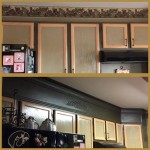Wood Stain Colors for Kitchen Cabinets: A Comprehensive Guide
Selecting the appropriate wood stain color for kitchen cabinets is a crucial decision that significantly impacts the overall aesthetic of the kitchen space. Wood stain, unlike paint, enhances the natural grain and texture of the wood, offering a warm and inviting look. The choice of stain color should complement the kitchen's existing elements, including countertops, flooring, appliances, and wall color. This article provides a detailed exploration of the factors to consider when choosing wood stain colors for kitchen cabinets, highlighting popular options and offering advice on achieving desired results.
Before delving into specific stain colors, it is important to understand the fundamental characteristics of wood stains. Wood stains are primarily composed of pigment or dye suspended in a solvent. The solvent carries the pigment into the wood pores, imparting color without completely obscuring the grain. The type of wood being stained will influence the final color achieved. Different wood species absorb stain at varying rates, resulting in subtle variations in the final appearance. Factors such as the wood's density, age, and existing finish all contribute to the final color outcome.
Understanding Wood Types and Stain Absorption
The inherent properties of the wood significantly affect how the stain is absorbed and how the final color appears. Some woods, like maple, are known for their tight grain and can be challenging to stain evenly. Others, like oak, have open grains that readily absorb stain, resulting in a more pronounced and defined grain pattern. Understanding these differences is vital in predicting the final stained appearance.
Oak: Oak is a popular choice for kitchen cabinets due to its durability and distinctive grain pattern. It readily absorbs stain, making it suitable for a wide range of colors. Red oak tends to have a pinkish undertone, while white oak has a more neutral tone. This difference should be considered when selecting a stain to ensure it complements the overall design.
Maple: Maple is a hardwood prized for its smooth, uniform surface. However, its closed grain makes it more resistant to stain absorption, which can sometimes result in blotchiness. To mitigate this, a pre-stain wood conditioner is often recommended. Lighter stains tend to work best on maple, highlighting its natural beauty without accentuating any inconsistencies.
Cherry: Cherry wood is known for its rich, reddish-brown hue that deepens and matures over time. It readily accepts stain and offers a luxurious and elegant appearance. However, cherry wood can be more expensive than other options. Using a stain that complements its natural warm tones is important to avoid an overly artificial appearance.
Pine: Pine is a softwood that is readily available and relatively inexpensive. Its light color makes it a good candidate for both light and dark stains. However, pine is prone to knots and sapwood, which can affect stain absorption. A pre-stain conditioner is generally recommended to ensure even coverage.
Birch: Birch is a closed-grain hardwood similar to maple but generally less expensive. It can be challenging to stain evenly and benefits from the application of a pre-stain wood conditioner. Lighter stains are often preferred to enhance its natural light color.
Popular Wood Stain Colors for Kitchen Cabinets
The selection of a wood stain color is highly dependent on the desired aesthetic and the existing design elements in the kitchen. The following are some popular wood stain color categories and their associated characteristics:
Light Natural Stains: Light stains showcase the natural beauty of the wood while providing a subtle hint of color. These stains are ideal for creating a bright and airy kitchen space. They work well with a variety of countertop materials and backsplash designs.
Medium Warm Stains: Medium warm stains offer a balanced and inviting look. They add warmth and depth to the kitchen without being overly dark. These stains are versatile and complement both traditional and contemporary designs. Common examples include shades of honey, amber, and golden oak.
Dark Rich Stains: Dark stains create a dramatic and sophisticated effect. They add a sense of luxury and elegance to the kitchen. Dark stains pair well with light countertops and backsplashes to create a visually appealing contrast. Examples include shades of espresso, mahogany, and dark walnut.
Gray-Toned Stains: Gray stains have become increasingly popular in recent years, reflecting a trend towards modern and minimalist design. These stains offer a cool and contemporary look that complements stainless steel appliances and other modern kitchen elements. They can range from light greys to darker, more dramatic charcoal tones.
White-Washed and Pickled Stains: These stains create a distressed and rustic look. They involve applying a light or semi-transparent white stain over the wood, allowing the grain to show through. This technique is often used to create a farmhouse or cottage-style kitchen.
Factors Influencing Stain Color Selection
Several key factors should be considered when selecting a wood stain color for kitchen cabinets. These factors include the existing kitchen design, the desired aesthetic, the amount of natural light available, and the maintenance requirements.
Existing Kitchen Design: The stain color should complement the existing elements in the kitchen, including countertops, flooring, appliances, and wall color. Consider the overall style of the kitchen – whether it is traditional, contemporary, rustic, or modern – and choose a stain color that aligns with that style. If the countertops are dark, a lighter stain can create a balanced and visually appealing contrast. Similarly, if the flooring is light, a darker stain can add depth and richness to the space.
Desired Aesthetic: The choice of stain color should reflect the desired aesthetic for the kitchen. Do you want a bright and airy space, a warm and inviting atmosphere, or a sophisticated and dramatic look? Light stains are ideal for creating a bright and airy kitchen, while dark stains create a more dramatic and sophisticated effect. Medium warm stains offer a balanced and versatile option.
Amount of Natural Light: The amount of natural light available in the kitchen will impact how the stain color appears. In a kitchen with plenty of natural light, darker stains can be used without making the space feel too small or enclosed. However, in a kitchen with limited natural light, lighter stains are generally preferred to maximize brightness.
Maintenance Requirements: Darker stains tend to show dust and fingerprints more readily than lighter stains. Consider the maintenance requirements when selecting a stain color. If you prefer a low-maintenance option, lighter stains may be a better choice. Also, the type of finish applied over the stain will affect its durability and resistance to scratches and stains.
Sample Testing: It is highly recommended to test the stain color on a sample piece of the same wood used for the cabinets before applying it to the entire surface. This allows you to see how the stain will look on the wood and to adjust the application technique if necessary. Apply the stain to the sample piece and let it dry completely before making a final decision. Consider viewing the sample under different lighting conditions to get a realistic idea of how the color will appear in the kitchen.
Consider the Undertones: Wood stains, much like paints, have undertones. These undertones can significantly impact how the stain color complements other elements in the kitchen. For instance, a stain with a yellow undertone may clash with countertops that have cool gray tones. Conversely, a stain with a red undertone might complement warm-toned granite countertops. Understanding the undertones of the stain and how they interact with other colors is crucial for achieving a harmonious overall design.
Layering Stains: For a more customized and unique look, consider layering multiple stain colors. This involves applying one stain color as a base and then applying a second, lighter stain over the top. This technique can create depth and dimension, highlighting the grain pattern of the wood and adding visual interest to the cabinets. Experiment with different combinations of stain colors to achieve the desired effect.
Professional Consultation: If you are unsure about which stain color to choose or how to apply it properly, consider consulting with a professional kitchen designer or wood finishing specialist. They can provide expert advice and guidance, helping you select the right stain color for your kitchen and ensuring that the application is done correctly.
In conclusion, choosing the appropriate wood stain color for kitchen cabinets involves careful consideration of numerous factors. Understanding the properties of different wood species, the characteristics of various stain colors, and the existing design elements in the kitchen are all crucial steps in the process. Testing the stain on a sample piece of wood and considering the maintenance requirements are also important. By carefully considering these factors, you can select a wood stain color that enhances the beauty of your kitchen cabinets and creates a warm and inviting space.

The New Cabinet Stain Colour For Kitchens Trends Wood

Cabinet Stain Colors Staining Cabinets Wood

3 Kitchen Cabinet Stain Colors Popular In Montgomery County Pa Dailey Manufacturing Co

Popular Wood Stain Colors From Brighton Cabinetry Kitchen Design Partner

Woods Stain Colors Kitchen Cabinets Buffalo Ny Kreative Kitchens Baths

Popular Wood Stain Colors From Brighton Cabinetry Kitchen Design Partner

How To Choose Kitchen Cabinet Color Awa Cabinets

Wood Stain Colors For Kitchen Cabinets Home Furniture Design Stained Staining Painting

Popular Wood Stain Colors From Brighton Cabinetry Kitchen Design Partner

Stain Color Selection For Kitchen Cabinets Nv Bathroom Remodeling Va
Related Posts








